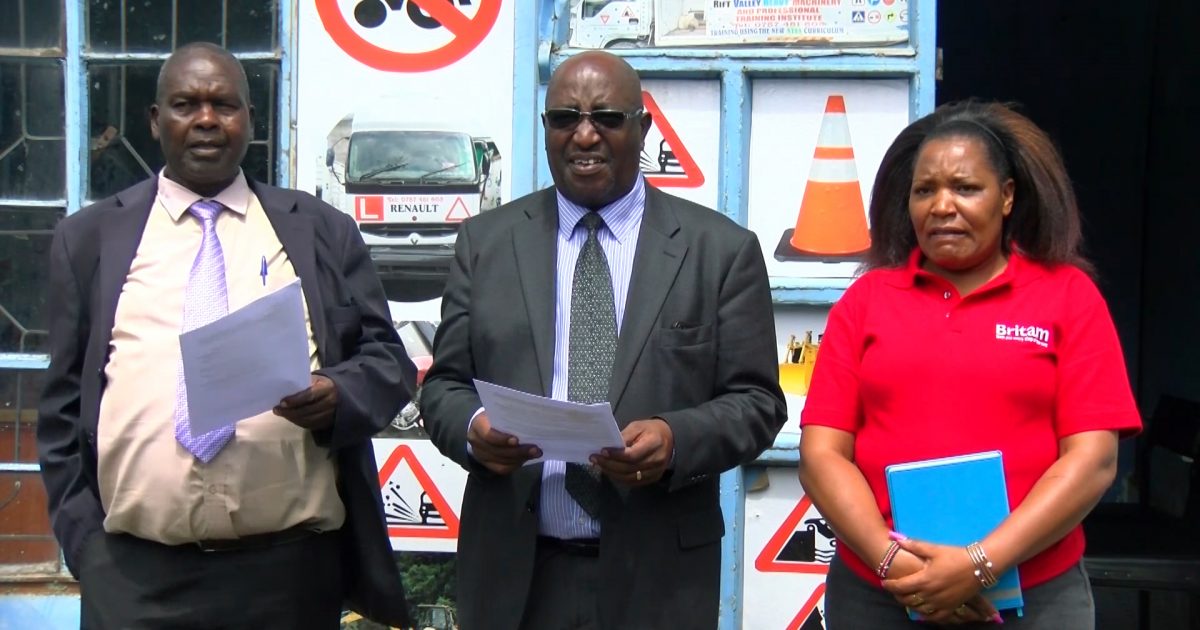The shocking upsurge in road accidents in the country has been blamed on preventable and predictable factors with stakeholders now calling for sanity to stop road carnages.
The Kenya Driving Schools Association (KDSA) has noted with concern that over 80 percent of accidents are caused by drivers’ behaviours such as drunk driving, recklessness, speeding, overloading and use of unroadworthy vehicles.
According to KDSA National Chairman Mr Kariuki Kamau attitudinal shifts are also required to instill into Kenyans a culture of safe road usage which entails observing speed limits, proper vehicle maintenance and respecting other road users, including cyclists and pedestrians.
Mr Kamau indicated that as the number of vehicles increases and the physical road infrastructure gets better, enhancing safety practices will minimize the number of facilities adding that Kenyans can avert accidents along the roads if everyone plays to the stipulated rules and guidelines.
Speaking to journalists in Nakuru the Chairman said that although like all other countries, Kenya is supposed to halve the deaths caused by road accidents by the year 2030 in line with United Nations Decade of Action for Road Safety, the reverse was being witnessed.
According to Mr Kamau, some public service vehicle (PSV) drivers are quacks who learnt the driving skill in the streets but have never bothered to go to a driving school.
The KDSA spokesman claimed that some unscrupulous elements at National Transport and Safety Authority (NTSA) have allegedly been colluding with instructors from rogue driving schools to issue untrained Kenyans with driving licenses.
He cited cases of two driving schools and some alleged unscrupulous NTSA officials who were placed under probe by the Directorate of Criminal Investigations for running a racket that issued driving licenses to unqualified Kenyans.
“We have driving schools that are working in cahoots with NTSA officials to issue driving licenses to people who have not attended any driving lesson in exchange for money. These drivers find themselves on the road and are the ones causing the many accidents we are witnessing,” said Mr Kamau.
He added; “NTSA should stop making kneejerk declarations whenever an accident occurs. They should be the biggest strong link in the campaign to stop road carnage.”
He regretted that drivers who acquire their licenses corruptly and in an unprocedural manner usually do not conform to the laid down road traffic rules to ensure their safety and that of others.
“We cannot continue watching our people die. We have a duty to ensure that we and those around us are safe. Let us all rise to the occasion and say not to recklessness, impunity on our roads,” Kamau stated.
He said that a significant proportion of the road accidents are a result of human error, corrupt practices and indiscipline while using roads.
“We have documented cases of untrained people verified as licensed drivers bribing their way out of custody whenever they are arrested. All these are factors that have created an environment that fosters road accidents,” the chairperson pointed out.
According to Kamau, some drivers cause accidents due to driving for long hours without taking enough rest, a blame which he heaped on the management of some PSV companies and long-distance cargo trailers.
The chairman claimed that many long-distance drivers partake in alcohol and other ‘stimulants’ so as to cover as much distance on a particular day, as they are paid based on trips they make leading to speeding, fatigue and recklessness.
He expressed concern that boda bodas have become such a menace that in some public hospitals, special wards have been set up to cater for victims of boda boda crashes.
The causes of these accidents according to Mr Kamau are varied, but the most common are alcohol and substance abuse and lack of discipline among riders.
Oftentimes, he added, riders get off the road and ride on pavements or any accessible open space and weave dangerously between moving vehicles.
He stated that contrary to road regulations, boda boda riders often carry more than one passenger, adding that some have been observed to carry as many as five with the rider perched dangerously on the fuel tank in a manner that makes it impossible for him to have full control of the motorbike, but more especially in case of an emergency.
“The tragedy is that in their haste, boda boda passengers seem completely unaware of the risks they expose themselves to. It is rare to find passengers donning safety helmets and reflective jackets that are a mandatory requirement,” he pointed out.
Mr Kamau said national crackdowns on boda bodas to ensure riders meet the requirements for doing business should be mounted regularly as opposed to the practice only when an accident occurs.
Most of the riders, he noted, have not gone through formal training, hence do not have licences, nor are they conversant with road safety rules. This he observed accounts for their attitude that demonstrates scant respect not just for other road users, but life as well.
He also attributed some of the accidents to dilapidated roads, adding that most of the accidents happen as drivers and riders try to avoid hitting potholes while at high speed.
Others, he said, are due to poor maintenance of vehicles like failure to replace worn-out tires.
He urged Kenyans to support reintroduction of alcoblow, to minimize many accidents that are happening on Kenyan roads.
Road accidents have killed 1,213 people in the past three months, data from the National Transport Safety Authority (NTSA) shows.
And pedestrians account for the largest number of fatalities at 445, followed by motorcyclists at 285 and passengers at 259.
According to the data captured between January and April 3, pillion (motorcycle) passengers came fourth at 103 followed by drivers (99) and pedal cyclists (24).
The deaths are an increase of 5.8 per cent from 1,146 during the same period last year. The deaths have, however, increased following the latest accidents this week on the Kericho-Nakuru and Nakuru-Eldoret highways, where 15 people died.
Early this month, two people died and at least 10 were injured when a bus they were travelling in rammed a truck on the James Gichuru-Rironi highway.
Four others died on Sunday morning when a Kensliver company bus with 39 passengers overturned at the notorious Nithi bridge on the Meru-Nairobi highway.
‘’Road accidents are a national catastrophe that we must address under an all-government, indeed all-public, approach,” said Cabinet Secretary for Roads and Transport Kipchumba Murkomen.
“In the past 20 years, we have been losing an average of 3,800 people annually. Many of these accidents are attributed to reckless driving and lack of respect for pedestrians. Others are caused by overloading and drunken driving.”
To address the problem, CS said the ministry is working to finalize the introduction of instant fines. “Even as we intensify joint enforcement of traffic rules, technology will, in the long run, reduce the errant behaviour of road users,” he said.
Murkomen said telematics, starting with school transport, will ensure all-time monitoring because of dashboard cameras and other features.
“We are also reintroducing roadside drink-driving tests. The NTSA will also get more resources to carry out its mandate in collaboration with other government agencies and help police in enforcement,” he added.
“In this national conversation, faith-based groups are critical and we will be reaching out to them and other stakeholders,” he said.
In September 2020, the UN General Assembly adopted a resolution proclaiming the Decade of Action for Road Safety 2021-2030, with the ambitious target of preventing at least 50 per cent of traffic deaths and injuries by 2030.
The World Health Organization and the UN regional commissions, in cooperation with other partners in the UN, have developed the Global Plan for the Decade of Action, which was released in October, 2021.
The NTSA has come up with a National Road Safety Action Plan 2023-2027 that targets a 50 per cent reduction in fatalities by 2030.
The Global Plan aligns with the Stockholm Declaration, by emphasizing the importance of a holistic approach to road safety, and calling on continued improvements in the design of roads and vehicles, enhancement of laws and law enforcement, and provision of timely, life-saving emergency care for the injured.
The Plan also reflects the Stockholm Declaration’s promotion of policies to promote walking, cycling and using public transport as healthy and environmentally sound modes of transport.
Progress made during the previous Decade of Action for Road Safety 2011-2020 has laid the foundation for accelerated action.
Among the achievements are inclusion of road safety on the global health and development agenda, broad dissemination of scientific guidance on what works, strengthening of partnerships and networks, and mobilization of resources.
This new Decade of Action provides an opportunity for harnessing the successes and lessons of previous years and building upon them to save more lives.
By Anne Mwale and Dennis Rasto





